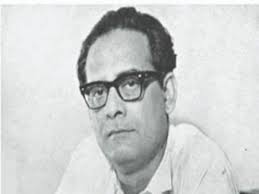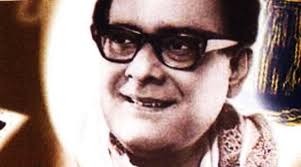
Hemanta Kumar Biography
The renowned Indian music director and playback singer Hemanta Mukhopadhyay (16 June 1920 – 26 September 1989), also professionally known as Hemant Kumar and Hemanta Mukherjee, sang mainly in Bengali and Hindi in addition to other Indian languages like Marathi, Gujarati, Odia, Assamese, Tamil, Punjabi, Bhojpuri, Konkani, Sanskrit, and Urdu. He performed Rabindra Sangeet, Bengali and Hindi cinema music, among many other genres. Often referred to as the “voice of God,” he won two National Awards for Best Male Playback Singer.

Hemanta Kumar Profile
- Full Name: Hemanta Mukhopadhyay
- Date of Birth: June 16, 1920
- Age: 103 (as of 2023)
- Gender: Male
- Place of Birth: Varanasi, Benares State, British India
- Nationality: Indian
- Profession: Singer, music director, producer
- Height: N/A
- Parents: N/A
- Siblings: Three brothers and a sister
- Spouse: Bela Mukherjee
- Children: Jayant (son), Ranu (daughter)
- Relationship Status: Married
- Net Worth: $3 million
Hemanta Kumar Early life and education

Hemanta was born at the home of his maternal grandfather, a doctor, in Varanasi. In the early 1900s, his paternal family moved from the town of Jaynagar Majilpur to Kolkata. Hemanta grew up and went to school in the Bhowanipore area, first at the Nasiruddin School and then at the Mitra Institution, where he met his lifelong friend Subhas Mukhopadhyay, who went on to become a poet in Bengal. During his education, he also became acquaintances with renowned writer Santosh Kumar Ghosh.
Hemanta enrolled in the engineering diploma program at the Bengal Technical Institute in Jadavpur, which is now Jadavpur University. Nevertheless, he left school to pursue a career in music despite his father’s disapproval because of a health issue. He dabbled in writing and had a short tale published in the Bengali magazine Desh, but by the late 1930s, he had turned his attention to music.
Hemanta Kumar Net Worth

At the time of his passing, Hemanta Kumar’s estimated net worth was $20 million.
His financial success was a result of his contributions to the music industry and his fruitful career as a vocalist, music director, and producer.
Hemanta Kumar Early music career

The 1940 Bengali film Rajkumarer Nirbbasan, which included music by S.D. Burman, had Hemanta’s first cinema song. Nimai Sanyas, which included music composed by Hariprasanna Das, came next in 1941. The Bengali non-film songs “Katha Kayonako Shudhu Shono” and “Amar Biraha Akashe Priya” were among Hemanta’s first original compositions in 1943. It was written by Amiya Bagchi.
In 1942, he sang his debut Hindi movie songs in Meenakshi. then, in 1944, Irada, whose music was composed by Amar Nath. Hemanta is regarded as the leading Rabindra Sangeet exponent. He sang Rabindra Sangeet for the first time on screen in the 1944 Bengali film Priya Bandhabi. “Pather Sesh Kothaye” was the tune. In 1944, he released his first Rabindra Sangeet disk under the Columbia label, which was not a film. “Aamar Aar Habe Na Deri” and “Keno Pantha E Chanchalata” were the songs. He had previously recorded the song “Aamaar mallikabone” for All India Radio/Akashvani, but sadly the record has faded into obscurity.
In 1947, he directed music for the Bengali film Abhiyatri, which was his debut feature film. Hemanta recorded a lot of songs during this period, and while many of them were well regarded by critics, he didn’t achieve significant commercial success until 1947. Jaganmay Mitra, Robin Majumdar, Satya Chowdhury, Dhananjay Bhattacharya, Sudhirlal Chakraborty, Bechu Dutta, and Talat Mahmood were a few of the male contemporary Hemanta singers in Bengali.
Hemanta Kumar Family

Hemanta has a sister named Nilima and three brothers. Tarajyoti, his younger brother, wrote short stories in Bengali. Amal, his younger brother, sang and created music for a few Bengali films, including Abak Prithibi and Hospital. With Hemant serving as music director, Amal also recorded a few songs in the 1960s, the most notable of which being Jiboner Anekta Path Eklai. Hemanta wed Bengali singer Bela Mukherjee in 1945.
Despite performing a few well-known songs in the film Kashinath, she did not actively pursue her singing career after getting married. Their daughter, Ranu, and son, Jayant, were their two children. In the late 1960s and early 1970s, Ranu also attempted a career in music, though with varying degrees of success. The Bengali cinema actress Moushumi Chatterjee and Jayant are wed.
Success and migration to Mumbai
Hemanta joined the Indian People’s Theatre Association (IPTA) in the middle of the 1940s and formed a partnership with composer and songwriter Salil Chowdhury, another ardent IPTA member. The 1943 Bengal famine and the apathy of the British government and affluent Indians to stop it were major factors in the formation of the Indian Pacific Treaty Association (IPTA). Hemanta recorded a song called “Ganyer badhu” (literally, “The rural bride”) in 1947. Salil Chowdhury wrote both the music and the lyrics. The six-minute song was sung at different speeds and lacked the traditional structure and romantic topic of a Bengali song. It was recorded on two sides of a 78 rpm disc.
It showed how the demons of starvation and the consequent poverty destroy the life and family of a picturesque, wealthy, and kind rural woman. Hemanta and Salil gained unexpected fame in eastern India because to this song, which also helped to put Hemanta ahead of his male peers. Over the ensuing years, Hemanta and Salil collaborated once more on a number of songs. Nearly all of these songs ended up becoming huge hits.
Hemanta began getting more requests for music composition for Bengali movies about the same time. Hemen Gupta, the filmmaker, received some. A few years later, Hemen relocated to Mumbai and asked Hemanta to write the music for his debut Hindi film, Anandmath, which he directed under the Filmistan label. In 1951, Hemanta moved to Mumbai in response to this appeal, where she joined Filmistan Studios. He called his new home in Mumbai’s Khar neighborhood after one of his favorite books by Gurudev Rabindranath Tagore, Gitanjali, in an effort to stay connected to his heritage. Anand Math’s music from 1952 received some degree of success. ‘Vande mataram’, sung by Lata Mangeshkar and arranged to a marching music by Hemanta, is arguably the most famous song from this film.
In the years that followed Anandamath, Hemanta composed the soundtrack for a few Filmistan films, including Shart, the songs from which gained some notoriety. Hemanta rose to fame in Mumbai at the same time as a playback singer.
Popular songs included “Yeh Raat Yeh Chandni Phir Kahan” from Jaal (1952), “Chup Hai Dharti” and “Teri Duniya Mein Jeene Se” from House No. 44 (1955), “Hai Apna Dil To Awara” from Solva Saal (1958), and “Na Tum Humen Jano” from Baat Ek Raat Ki (1962) were written for actor Dev Anand under the direction of S. D. Burman. He composed the music for all of these movies. In the 1950s, he also played support for other Hindi film heroes, including as Dharmendra (Anupama), Biswajeet (Bees Saal Baad, Bin Badal Barsaat, Kohra), and Pradeep Kumar (Nagin, Detective).
Hemanta Kumar Career rise
Hemanta had solidified his status as a well-known singer and composer by the middle of the 1950s. He was probably the most sought-after male vocalist in Bengal and one of the leading exponents of Rabindra Sangeet. Hemanta Mukherjee arranged a ceremony in Calcutta in March 1980 to honor the renowned Rabindra Sangeet exponent Debabrata Biswas (1911–1980). Without hesitation, Biswas referred to Hemanta as “the second hero” who popularized Rabindra Sangeet, the first being the renowned Pankaj Kumar Mullick. Hemanta not only made a name for herself as a playback singer in Mumbai but also as a composer.
He wrote the music for the 1954 Hindi film Nagin, which went on to become a huge hit thanks in large part to its soundtrack. Songs from Nagin ended up staying at the top of the charts for two years straight, and in 1955, Hemanta won the esteemed Filmfare Best Music Director Award. He composed the music for the Bengali film Shap Mochan that same year, and he performed four songs for Uttam Kumar. This marked the beginning of Hemanta and Uttam’s lengthy collaboration as a playback singer-actor duo. For the ensuing ten years, they were the most well-liked singer-actor team in Bengali film.
Hemanta recorded multiple Rabindra Sangeet and Bengali non-film songs in the later half of the 1950s, in addition to writing music and performing for a number of Bengali and Hindi films. Nearly all of these achieved great popularity, particularly his Bengali tunes. This nearly ten-year era can be considered the pinnacle of his career. Hemanta has been described by Salil Chowdhury and Lata Mangeshkar as the Voice of God.
He sang songs written by Salil Chowdhury, Robin Chatterjee, and Nachiketa Ghosh—three of Bengal’s most prominent music directors. Harano Sur, Marutirtha Hinglaj, Neel Akasher Neechey, Lukochuri, Swaralipi, Deep Jwele Jaai, Shesh Parjanta, Kuhak, Dui Bhai, and Saptapadi in Bengali, and Jagriti and Ek Hi Raasta in Hindi are a few of the noteworthy movies for which Hemanta himself created music during this time.
Movie production
Hemanta started his own film production company, Hemanta-Bela productions, in the late 1950s. Neel Akasher Neechey (1959), a Bengali film directed by Mrinal Sen, was the first film released under this label. The narrative revolved around the struggles faced by a Chinese street vendor in [Calcutta] against the backdrop of India’s war for independence. The film went on to get the President’s Gold Medal, the highest award given by the Indian government to a motion picture.
Hemanta’s production firm, now called Geetanjali Productions, produced other Hindi films in the following ten years, including Rahgir, Bees Saal Baad, Kohraa, Biwi Aur Makaan, Faraar, and Khamoshi, all of which featured Hemanta’s music. The only two notable commercial triumphs were Bees Saal Baad and Khamoshi.
When Hemanta returned to Bengal, he tried his hand at fusing Bengali traditional music with light music for the 1963 film Palatak. This turned out to be a huge hit, and Hemanta’s compositional approach changed significantly for several of his subsequent Bengali movies, including Balika Badhu and Baghini. His music had a hint of light classical in the Bengali films Manihar and Adwitiya, both of which were huge commercial and musical hits.
A significant amount of the Gramophone Company of India’s 1961 commemorative output contained Rabindrasangeet by Hemanta in honor of Rabindranath Tagore’s centennial of birth. This turned out to be a huge commercial success as well. Hemanta had multiple international performance tours, one of which was to the West Indies. All things considered, he managed to hold onto his status as the leading male vocalist in Bengal and as a significant composer and singer in Hindi cinema during the 1960s.
He was the main male voice and main character in many of Tagore’s musical dramas in the 1960s, including Valmiki Pratibha, Shyama, Sapmochan, Chitrangada, and Chandalika. Alongside the two leading female voices in these, Kanika Bandopadhyay (1924–2000) and Suchitra Mitra (1924–2010), he formed the well-liked and esteemed Rabindra Sangeet triad. Known as “Hemanta-Kanika-Suchitra,” this quartet—which also included Debabrata Biswas—was and is the most often heard performers of Tagore works. The other prominent Rabindra Sangeet exponents at the time were Asoktaru Bandopadhyay, Chinmoy Chattopadhyay, Sagar Sen, Sumitra Sen, and Ritu Guha.
Hemanta Kumar Later career

Hemanta made a meager contribution to Hindi movies in the 1970s. He composed music for a few of his own films, but neither the films nor the music were commercially successful. Still, he was Bengal’s most prominent Rabindra Sangeet performer of both movie and non-movie songs. For the most of the decade, his work remained in high demand. Several of them include Jeona Daraon Bandhu (Phuleswari, 1975), Ke Jane Ko Ghonta (Sonar Khancha, 1974), Jodi Jante Chao Tumi (1972), Ek Gochha Rajanigandha, Aamay Prasno Kore Nil Dhrubatara, Sedin Tomay Dekhechilam (1974), Khirki Theke Singho Duar (Stree, 1971), and popularized Rabindra sangeet by skillfully utilizing them in films according to situations. The 1980 Dadar Kirti song Chorono Dhorite Diyogo Amare is a well-known and iconic example.
Hemanta made his feature film debut in 1971 with his independently produced Bengali film Anindita. It wasn’t very successful at the box office. But one of his greatest and most well-liked interpretations of Rabindra Sangeet was Diner Seshe Ghumer Deshe. Hemanta responded to film director Conrad Rooks in the same year that he moved to Hollywood, scoring the music for Conrad’s Siddhartha and performing O Nadire (which he had written and performed for Neel Akasher Neechey (1959)). He was the first singer from India to make a Hollywood comeback. As the first-ever Indian singer to receive US citizenship, Hemanta was recognized by the US government by being granted Baltimore, Maryland, citizenship.
Two prominent Bengali music composers who had collaborated extensively with Hemanta from the early 1950s, Nachiketa Ghosh and Robin Chatterjee, passed away in the early to mid-1970s. Concurrently, Hemanta’s soundtracks for Bengali movies such as Phuleswari, Raag Anurag, Ganadebata, and Dadar Kirti made him a prominent figure in the Bengali cinema industry. Hemanta re-recorded a few of his early pieces from the 1940s and 1950s alongside composer Salil Chowdhury in 1979. The second volume of this CD, Legend of Glory, was a huge commercial hit. Hemanta suffered a heart attack in 1980 that had a major impact on his voice, particularly on his ability to manage his breath.
In the early 1980s, he kept recording songs, but his voice had lost much of its rich baritone quality. Hemanta received awards in 1984 for her 50 years in music from a number of organizations, the most prominent of which being the Gramophone Company of India. In that same year, Hemanta’s final album with Gramophone Company of India was issued on a 45 rpm extended play disk featuring four songs that weren’t from movies. Hemanta released a few non-film tracks for up-and-coming small-time labels in the emerging cassette-based music business throughout the course of the following several years. Merely a handful of these achieved commercial success. He wrote the music for one Bengali and one Hindi teleseries, as well as a few Bengali films.
By now, though, he was an institution, a well-liked and respected figure who was a kind and cordial gentleman. One of his charitable endeavors was to operate a homeopathic hospital in their hometown of Baharu, West Bengal’s South 24 Parganas district, in honor of his late father. During this time, he continued to appear frequently on Doordarshan (TV), All India Radio, and live shows and concerts. In an early 1990s television interview with elocutionist Gauri Ghosh, his wife Bela Mukherjee recalled that she was unaware of the number of families and individuals he supported, whether financially or otherwise, while he was alive; this information only came to light gradually after his death.
Having declined an earlier invitation to win a Padma Shri in the 1970s, he graciously declined a nomination for the Padma Bhushan in 1987. This year, Lata Mangeshkar gave him a souvenir on behalf of his supporters and admirers at a public celebration of his 50 years in the music industry held at the Netaji Indoor Stadium in Kolkata.His performance in the movie “Lalan Fakir” earned him the 1988 Best Male Singer award despite his deteriorating voice.
He went to Dhaka, Bangladesh in September 1989 to give a concert and collect the Michael Madhusudan Award. Shortly after his return from this journey, on September 26, 1989, he experienced another heart attack and passed away at a South Kolkata nursing home at 11:15 p.m.
Hemanta Kumar Death and legacy

Hemant became unwell on September 26, 1989, following his return from a Dhaka concert. Shortly later, he suffered a major heart arrest and passed away. In the words of his daughter-in-law Moushumi Chatterjee, “Ki koshto, ki koshto” means “such pain, such pain.”
The music that Hemant composed and the songs he recorded throughout his lifetime continue to carry his legacy. The Gramophone Company of India, often known as Saregama, continues to produce at least one album of his each year, repackaging his older songs because of their financial viability.
Hemanta Kumar Social Media
- Instagram handle: N/A
- Twitter handle: N/A
Hemanta Kumar Discography
- Nagin
- Bees Saal Baad
- Anand Math
- Siddhartha
- Kohraa
- Palatak
- Raag Anurag
- Phuleshwari
- Swaralipi
- Duti Mon
Which was the first song of Hemanta Mukhopadhyay?
His initial Hindi tracks, “o priit nibhaabewaalii” and “kitanaa dukh bhulaaya tumane,” were published in 1940 under the Columbia label of GCI. Faiyaz Hashmi wrote the words and Kamal Dasgupta composed the music for these songs. In the 1941 Bengali film “Nimai Sanyas,” he sang his debut movie song.
Who is the voice of God Hemant Kumar?
He performed Rabindra Sangeet, Bengali and Hindi cinema music, among many other genres. He was referred to be the “voice of God” and won two National Awards for Best Male Playback Singer.
When was Hemant Kumar born?
Hemant Kumar, also known as… Born on June 16, 1920, Hemanta Mukherjee (Kumar) is a music director, producer, and performer for Hindi and Bengali films. Bela Mukherjee and Kumar were wed, and they had two kids together. Kumar appeared in a number of popular movies, such as Anjaan (1956) and Do Dooni Chaar (1968).
How is Hemant Kumar related to Moushumi Chatterjee?
In addition to working with Rishi, Moushumi Chatterjee also collaborated with Shashi Kapoor, whom she referred to as “uncle” because they had previously worked together because Hemant Kumar, the late music director and vocalist, was Moushumi’s father-in-law.
Who is the owner of Hemant Kumar musical group?
Shri Hemantkumar Mahale founded the Hemantkumar Musical Group (HMG), which is based in Mumbai, India, in 1978.
Discover more from Labaran Yau
Subscribe to get the latest posts sent to your email.



















